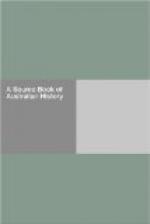On the next morning, leaving two men to take care of the horses and provisions, they proceeded to cut a path through the thick brushwood, on what they considered as the main ridge of the mountains, between the Western River, and the River Grose. They now began to mark their track by cutting the bark of the trees on two sides. Having cut their way for about five miles, they returned in the evening to the spot on which they had encamped the night before. The fifth day was spent in prosecuting the same tedious operation, but, as much time was necessarily lost in walking twice over the track cleared the day before, they were unable to cut away more than two miles further. They found no food for the horses the whole way.
On Sunday, they rested and arranged their future plans. They had reason, however, to regret this suspension of their proceedings, as it gave the men leisure to ruminate on their danger, and it was for some time doubtful whether, on the next day, they could be persuaded to venture farther.
On Wednesday, the 19th, the party moved forward, bearing chiefly west, and west-south-east. They now began to ascend the second ridge of the mountains, and from this elevation they obtained for the first time an extensive view of the settlements below.
At a little distance from the spot at which they began the ascent, they found a pyramidical heap of stones, the work, evidently, of some European, one side of which the natives had opened, probably in the expectation of finding some treasure deposited in it. This pile they concluded to be the one erected by Mr. Bass, to mark the end of his journey. That gentleman attempted some time ago to pass the Mountains, and to penetrate into the interior, but having got thus far, he gave up the undertaking as impracticable, reporting, on his return, that it was impossible to find a passage even for a person on foot. Here, therefore, the party had the satisfaction of believing that they had penetrated as far as any European had been before them.
[This, however, proved to be Caley’s Cairn.]
May 21st.—Their progress the next day was nearly four miles. They encamped in the middle of the day at the head of a well-watered swamp, about five acres in extent; pursuing, as before, their operations in the afternoon. In the beginning of the night the dogs ran off and barked violently. At the same time something was distinctly heard to run through the brushwood, which they supposed to be one of the horses got loose; but they had reason to believe afterwards that they had been in great danger—that the natives had followed their tracks, and advanced on them in the night, intending to have speared them by the light of their fire, but that the dogs drove them off.




